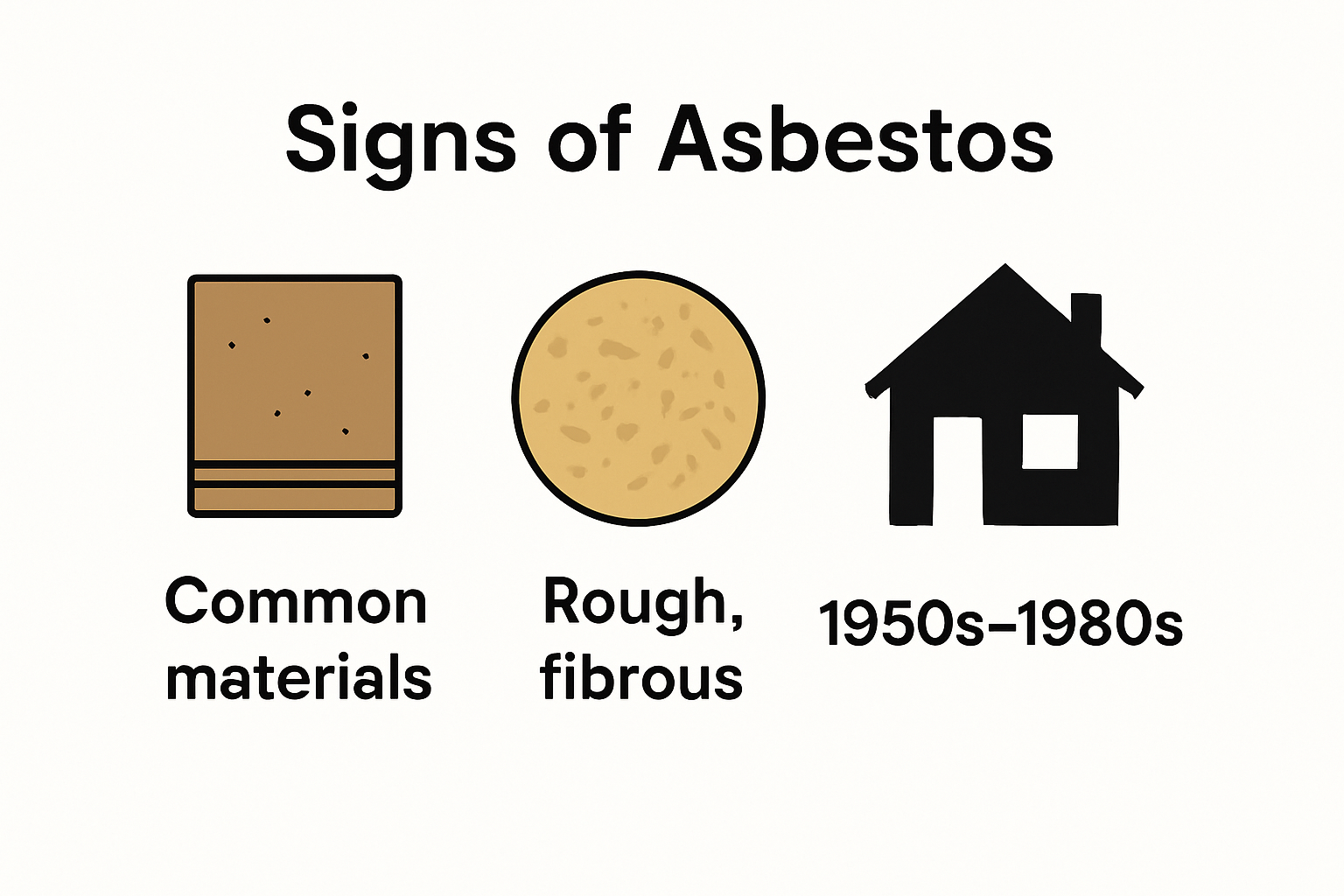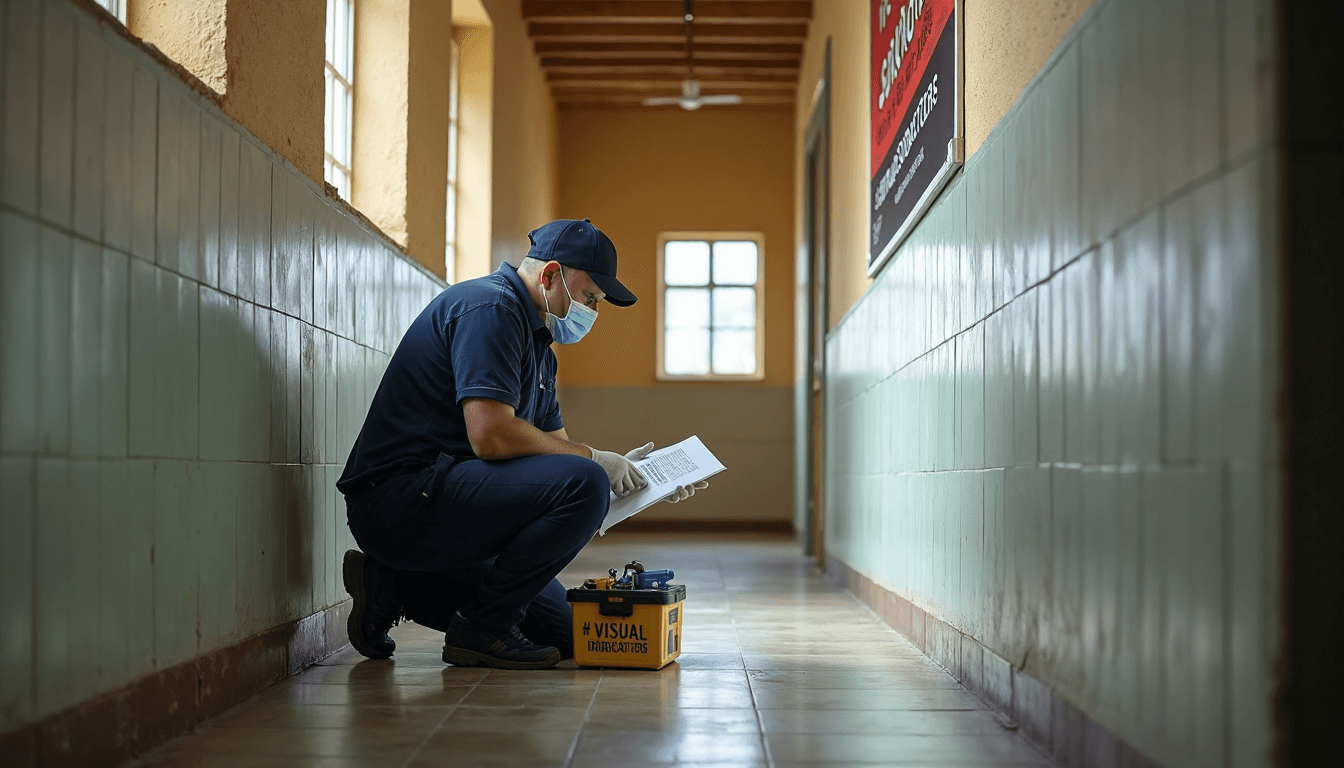Think your Cape Town home is safe just because the paint looks fresh and the roof tiles seem solid? Think again. Nearly 40 percent of properties built before 1990 in Cape Town still contain hidden asbestos, putting families at risk without them even realising it. What’s really wild is that the biggest warning signs are hiding in plain sight right inside your living spaces.
Table of Contents
- Common Signs Asbestos Is Present Indoors
- High-Risk Areas For Asbestos In Cape Town Buildings
- What To Do If You Suspect Asbestos On Your Property
Quick Summary
| Takeaway | Explanation |
|---|---|
| Identify Visual Indicators | Look for materials like textured ceiling tiles, corrugated roofing, and certain floor tiles in buildings built before 1990 as potential signs of asbestos presence. |
| Engage Professional Services | If you suspect asbestos, do not attempt personal sampling; hire certified inspectors who can safely collect and analyze samples. |
| Prioritize Legal Compliance | Property owners must maintain a comprehensive asbestos inventory, develop a management plan, and ensure professional remediation to avoid legal repercussions. |
Common Signs Asbestos Is Present Indoors
Identifying asbestos within indoor environments requires careful observation and understanding of potential warning indicators. Most buildings constructed before the 1990s harbor hidden asbestos materials, presenting significant health risks for occupants. Recognizing these signs becomes crucial for property owners and residents seeking to protect their health and safety.
Visual Indicators of Potential Asbestos Presence
Some materials commonly found in older properties provide clear visual clues about potential asbestos contamination. Textured ceiling tiles with a distinct grayish or white appearance, particularly in homes built between 1950 and 1980, often contain asbestos. Insulation around boilers, pipes, and electrical systems featuring a fibrous, wrapped material might also signal asbestos presence.
According to the National Institute of Occupational Health in South Africa, certain building materials are more likely to contain asbestos, including:
- Roofing materials with a corrugated cement-like appearance
- Ceiling boards with a particular textured finish
- Pipe insulation featuring wrapped fibrous coverings
- Floor tiles with vintage designs from pre-1990s installations
Homeowners should pay special attention to these specific architectural elements, understanding that visual inspection alone cannot definitively confirm asbestos presence.
Here’s a table summarising common visual indicators that might signal asbestos presence in older Cape Town buildings:
| Material Type | Typical Appearance | Construction Period Most Common |
|---|---|---|
| Roofing materials | Corrugated, cement-like sheets (often grey) | 1950 – 1990 |
| Ceiling boards | Textured, rough white or grey finish | 1950 – 1980 |
| Pipe insulation | Wrapped fibrous coverings (‘stringy’ material) | 1950 – 1980 |
| Floor tiles | Vintage styles; often 9-inch tiles; dull colours | pre-1990 |
| Boiler insulation | Thick, fibrous blanket wrapping | 1950 – 1985 |
Structural Age and Asbestos Likelihood
The construction period of a building serves as a critical indicator for potential asbestos contamination. Research from the Mayo Clinic confirms that structures built before 1980 have a significantly higher probability of containing asbestos-based materials. South African buildings from this era frequently incorporated asbestos in construction due to its perceived durability and fire-resistant properties.
Property owners should exercise heightened caution when dealing with buildings constructed between 1950 and 1990. Specific architectural elements like cement sheeting, roof tiles, floor underlayment, and thermal insulation represent high-risk zones for potential asbestos contamination. Professional assessment becomes essential when these structural characteristics are present.
Professional Diagnostic Approaches
While visual indicators provide initial insights, definitive asbestos identification requires professional testing. Certified asbestos inspectors utilize specialized techniques to collect and analyze material samples without risking widespread contamination. These professionals employ microscopic analysis and laboratory testing to confirm the presence of asbestos fibers.
Homeowners and property managers should never attempt personal sampling, as disturbing potential asbestos-containing materials can release dangerous microscopic fibers into the air. National regulations in South Africa mandate professional handling of suspected asbestos materials to prevent environmental and health risks.
Recognizing potential asbestos signs represents the first critical step in protecting indoor environments. Professional assessment, combined with careful observation, ensures comprehensive safety for residents and property occupants.
High-Risk Areas for Asbestos in Cape Town Buildings
Cape Town’s architectural heritage presents unique challenges in identifying and managing asbestos-containing materials across various building types. Understanding the high-risk areas becomes crucial for property owners and residents seeking to protect their health and safety.
Here’s a summary table that highlights the highest-risk locations in different Cape Town building types, helping readers quickly identify where asbestos may be found:
| Building Type | Typical High-Risk Asbestos Areas |
|---|---|
| Residential (1950-1990) | Roof sheeting, ceiling boards, floor tiles, pipe insulation |
| Historical Structures | Roof and wall cladding, ceiling panels, exterior pipes |
| Industrial Facilities | Mechanical rooms, insulation, warehouse walls/ceilings |
| Commercial Buildings | HVAC ducts, electrical compartments, wall panels |
| Public Buildings | Ceiling tiles, ventilation systems, exterior cladding |
Residential Properties and Historical Structures
Older residential buildings in Cape Town, particularly those constructed between 1950 and 1990, represent significant asbestos risk zones. The National Institute of Occupational Health highlights that many homes from this era incorporated asbestos materials in multiple construction elements. Specific high-risk areas within residential properties include:
- Roof sheeting with corrugated cement-like appearance
- Ceiling boards and insulation materials
- Floor tiles and backing materials
- Pipe insulation and exterior cladding
Historical homes in suburbs like Woodstock, Observatory, and Salt River often feature these architectural elements, making thorough inspection essential. Learn more about our comprehensive property inspection services.
Industrial and Commercial Building Zones
Industrial facilities and older commercial buildings in Cape Town present even more complex asbestos contamination risks. According to Asbestos Abatement Regulations of 2020, building owners must conduct comprehensive asbestos inventories. High-risk areas in these settings include:
- Mechanical rooms with outdated insulation
- Electrical system compartments
- Old warehouse structural components
- Factory ceiling and wall materials
- HVAC system ducting and surrounding insulation
Manufacturing facilities in industrial zones like Epping and Parow are particularly vulnerable, with many structures retaining original construction materials from pre-1990s periods.
Infrastructure and Public Buildings
Public infrastructure represents another critical area of asbestos concern in Cape Town. Schools, government buildings, and older community centers constructed before asbestos restrictions were implemented often contain multiple asbestos-containing materials. Research from South African occupational health experts indicates these structures may have asbestos in:
- Ceiling tiles and acoustic panels
- Ventilation systems
- Electrical and utility closets
- Exterior wall cladding
- Underground piping systems
Property managers and public administrators must prioritize professional assessment and potential remediation to ensure community safety. The complexity of identifying asbestos in these environments requires specialized expertise and careful diagnostic approaches.
Recognizing these high-risk areas represents the first critical step in managing potential asbestos exposure. Professional evaluation, combined with a comprehensive understanding of Cape Town’s architectural history, ensures proactive protection for residents and workers across various building types.
What To Do If You Suspect Asbestos On Your Property
Discovering potential asbestos on your property requires immediate and strategic action to protect your health and comply with legal requirements. Property owners in Cape Town must approach suspected asbestos contamination with caution and professional guidance.
Initial Assessment and Safety Precautions
When asbestos is suspected, the first critical step is to minimize potential exposure. Government regulations mandate specific protocols for managing potentially hazardous materials. Homeowners should:
- Avoid disturbing any suspected asbestos-containing materials
- Restrict access to the potentially contaminated area
- Do not attempt personal sampling or removal
- Keep children and pets away from suspected zones
Professional assessment becomes crucial at this stage. Learn more about our comprehensive property inspection services to understand the full scope of potential asbestos risks.
Professional Diagnostic and Removal Process
According to South African Labour Department regulations, asbestos removal must be performed exclusively by registered asbestos contractors. These certified professionals follow a rigorous process:
- Comprehensive site inspection and material sampling
- Laboratory analysis to confirm asbestos presence
- Detailed risk assessment and management plan
- Safe containment and removal strategies
- Proper disposal of asbestos-containing materials
Property owners must engage only registered contractors who can provide official documentation of their qualifications and removal procedures. The removal process requires approved permits from the Department of Labour, ensuring strict compliance with national safety standards.
Here’s an easy-to-scan table outlining the steps asbestos contractors follow during removal, as mentioned in the article:
| Step Number | Action Taken | Purpose |
|---|---|---|
| 1 | Site inspection and material sampling | Identifies possible asbestos |
| 2 | Laboratory analysis | Confirms asbestos presence |
| 3 | Risk assessment and management plan | Outlines safe remediation steps |
| 4 | Containment and removal strategy | Prevents fibre releases |
| 5 | Safe disposal of asbestos materials | Ensures legal, safe removal |
Legal and Health Compliance Requirements
South African property owners have specific legal obligations when asbestos is identified. Government guidelines require:
- Compiling a comprehensive asbestos inventory
- Developing a formal management plan
- Reviewing the plan every 24 months
- Maintaining detailed documentation of all assessments
- Ensuring professional remediation by registered contractors
Failure to comply with these regulations can result in significant legal and financial consequences. Health risks associated with asbestos exposure include serious respiratory conditions and potential long-term medical complications.
Navigating asbestos detection and removal requires a systematic approach prioritizing safety, legal compliance, and professional expertise. Property owners in Cape Town must treat potential asbestos contamination as a serious health and environmental concern, seeking immediate professional guidance to protect themselves and their communities.
Frequently Asked Questions
What are the common signs that asbestos is present in a Cape Town home?
Look for visual indicators like textured ceiling tiles, corrugated roofing materials, and certain floor tiles, particularly in buildings constructed before 1990.
How can I safely determine if my property has asbestos?
While visual inspection can provide initial clues, a professional assessment by certified asbestos inspectors is essential for safe and accurate identification and analysis.
What should I do if I suspect asbestos on my property?
Immediately restrict access to suspected areas, avoid disturbing materials, and contact professional asbestos removal contractors for an inspection and potential remediation.
What are the legal requirements for asbestos management in South Africa?
Property owners must compile a comprehensive asbestos inventory, develop a management plan, conduct regular reviews, and ensure professional remediation to comply with laws and regulations.
Protect Your Cape Town Property from Hidden Asbestos Risks
Living in Cape Town means older buildings often hide dangers that go unseen. The article above makes it clear that asbestos can lurk in your roof sheeting, textured ceilings or even vintage floor tiles. If you own or manage property built before 1990, the threat is real. The risk is not just about compliance with new laws. It is about protecting your family’s health and the value of your investment.
Do not wait for visible signs of damage or health warnings. Get help from the local experts trusted in Cape Town since 1990. Wilcote Cape Town provides not just professional asbestos removal and property inspections, but complete solutions for roofing, waterproofing, and safe renovations. Visit our main site to request your free quote or book an on-site assessment today. A safe, healthy home starts with an expert you can trust.
Recommended
- Flat Roof Maintenance Tips for Cape Town Property Owners 2025 – wilcotecapetown.co.za
- What Is Flat Roof Repair? 2025 Guide for Cape Town Properties
- Roof Waterproofing Solutions for Cape Town in 2025
- Commercial Roofing Cape Town: Expert Solutions for 2025
- Roof Waterproofing for Cape Town Homes and Businesses
- Preventative Maintenance Roofing Guide for Cape Town 2025




